
Because Dartford Creek was a navigation (used at least since Roman times, it was improved by an Act of Parliament in 1840, with work completed in 1844) bridges across it had to allow for the passage of the vessels using it, presumably in its heydays Thames sailing barges. At this point there was a lifting bridge, but by 1985 the bridge itself had disappeared. It doesn’t look a great deal different now, though perhaps a little harder to see as the vegetation on the banks has grown considerably. The riverside path itself has been considerably upgraded and there are more fences to keep people away from the banks, and the brick building close to the bridge replaced by an undecorated large modern shed.
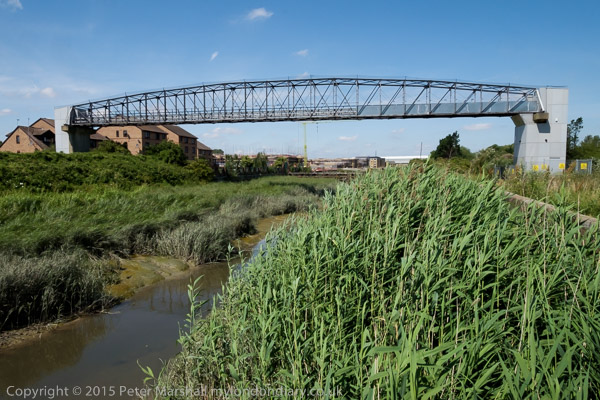
The pipe bridge looks a post-war construction, and once I think linked parts of the pharmaceutical works on both sides of the river; now on the west is a new housing estate, and little sign of anything to the east. But even at the date it was built, a high clearance was deemed essential, though sailing barges had probably given way to diesel.

By the footpath now are signs about the activities of the Friends of Dartford and Crayford Creek, and a little further on at Dartford Lock we came across one of them, working away at the vegetation on the bank. There was a hot sun and he was sweating and happy to stop for a few minutes and tell us about the navigation and the work of the friends – and told us to look out later for a yacht which was to try and enter the river from the Thames in a couple of hours on the rising tide.
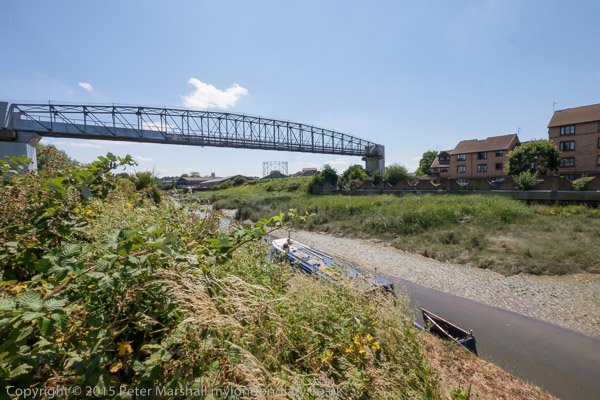
Next to where he was working a narrow boat was moored. This year apparently saw the first boats to come up above the lock since 2006 and the first to be moored overnight for 40 years. Thanks to the ‘Friends’ the lock has been made more usable, with a stretch of over 200 ft of quayside cleared to allow mooring. The port has silted up considerably over the years, and become covered with grass and weeds in places – according to the link there are now “mud banks over amost 80% of the total port area to heights varying from half a meter to a meter and a half.” and the stream at low tide as little as six inches deep. The port used to handle boats with a draught of one metre, and Dartford lock was a barrier to retain water above it to maintain a minimum depth of around 0.6 metres.
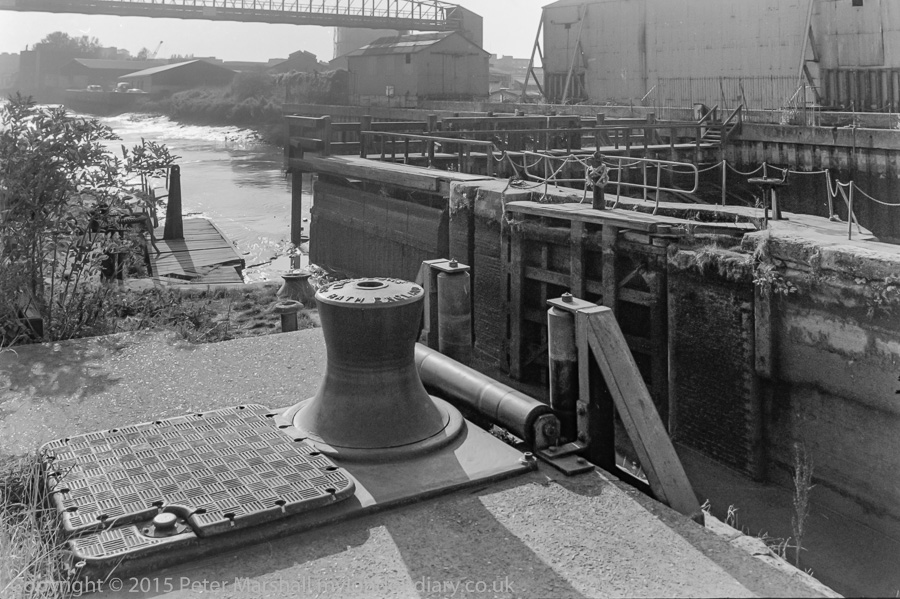
Back in 1985, the lock with its single gate appeared to be still in reasonable condition, possibly even capable of working, though obviously not well kept up, and the landing stage at the left clearly rather dangerous. I didn’t take many pictures – and here I think I was fairly clearly trespassing so perhaps fewer than I might otherwise have done. You can see there is far less mud on the bank at right and considerably less vegetation on both sides, though the older picture was taken in October when some might have died down slightly.
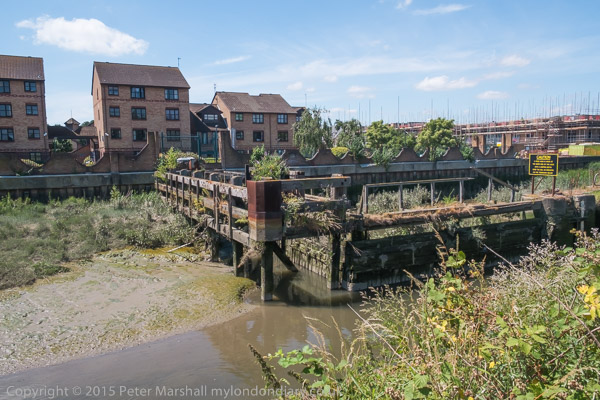
Things have clearly deteriorated since then, although the ‘Friends’ have carried out some work, getting the gate to open more fully and cutting down the flow of water around the lock, which was preventing the cill (or sill) in the lock from carrying out its purpose of maintaining the river level above it.


Below the lock the path is perhaps less interesting, following a winding path on an embankment with the river on one side and the long stretch of fairly empty fields and marshland to the east. There used to be a fireworks factory (and some of its isolated buildings remain) and further away an isolation hospital. In the distance you can see the Dartford Bridge and the now disused Littlebrook Power station, and as you get closer the Darent Tidal Flood Barrier and the River Thames. You pass the northern bypass (now renamed Bob Dunn way after the university that University Way was supposedly to lead to changed its mind about coming here) and the mouth of the River Cray (also part of the navigation.) It’s a pleasant enough walk, but one with no shade at all and we were pleased to find a hedge close to the flood barrier where we could sit at least partly in shade to eat our sandwiches.
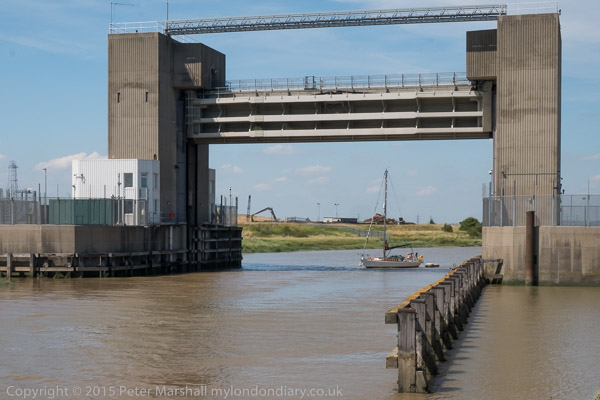
From where we were sitting we could see the mast of a yacht turn into the mouth of the Darent and I jumped up and ran to photograph it as it made its way under the flood barrier – with plenty of clearance – and made its way up river with the incoming tide and under power. It had hoped to get under the low bridge at Bob Dunn Way (with mast lowered) but I read later from the ‘Friends’ Facebook Page that the tide was too high when it reached there.
Pictures from the whole of this 2015 walk: Darent Valley Path & Thames
Continued at Dartford to Greenhithe Part 3)
For the walk in 2015 I was working with my newly arrived Fuji-X 10-24mm (15-36mm eq) on the X-T1 and the Fuji-X 18-55mm on the X-E1. Both excellent lenses which it is hard to fault in any way. I also carried but didn’t use the Samyang 8mm fisheye, probably because I was walking with two other people, and its a lens that makes me take a long time thinking about composition. The 10mm was wide enough for what I wanted to do, and considerably easier to use.
The only problem I had (apart from the cursed Fuji deep sleep mode – where the quickest way to elicit any response from the camera is to switch it off and then on again – a relatively minor annoyance with landscape, but which essentially makes the cameras hardly usable for covering protests) was that the times on the two cameras were not synchronised. It’s great to have clocks in cameras, time-stamping every image in the EXIF data, and I rely on it to put my images in order. But it would be nice if they kept time better. Though both were set at some point accurate to the nearest second, they were about 45 seconds apart. Yes, I should check and synchronise regularly.
Lightroom does make it very easy to select all the images from one camera and then adjust the time of all of them by the same amount, but I hadn’t done so when I wrote out the images for the web site, so you may notice the odd one out of order.
Back in 1985 we had no such problems. All I had to rely on when taking pictures was a notebook, and I wasn’t too good at making entries in that. But at least images were fixed on the film in the order that they were taken, and looking at the contact sheets I could normally reconstruct walk in my mind.
The Olympus 35mm shift lens I took most pictures with at the time was a fairly early version and not multi-coated as later otherwise identical versions were, and was fairly liable to flare and ghosting. You can see a neat but large hexagon in one of the images above. Working with scans does enable at least some recovery of what in the darkroom would have been very difficult negatives.
______________________________________________________
My London Diary : Buildings of London : River Lea/Lee Valley : London’s Industrial Heritage
All photographs on this and my other sites, unless otherwise stated, are taken by and copyright of Peter Marshall, and are available for reproduction or can be bought as prints.
To order prints or reproduce images
________________________________________________________
One thought on “Dartford to Greenhithe (part 2)”